
 |
Eager Space | Videos | All Video Text | Support | Community | About |
|---|

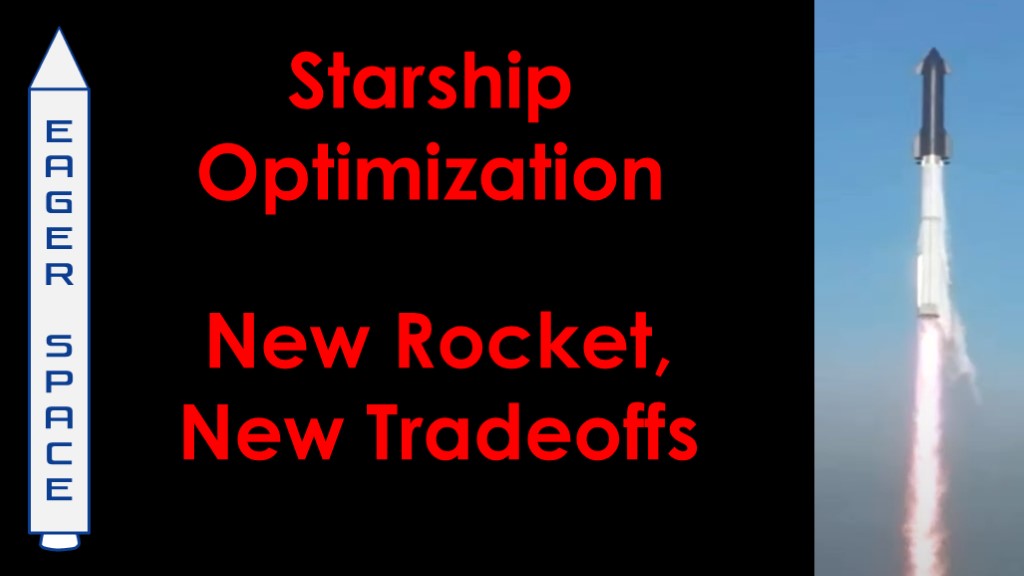
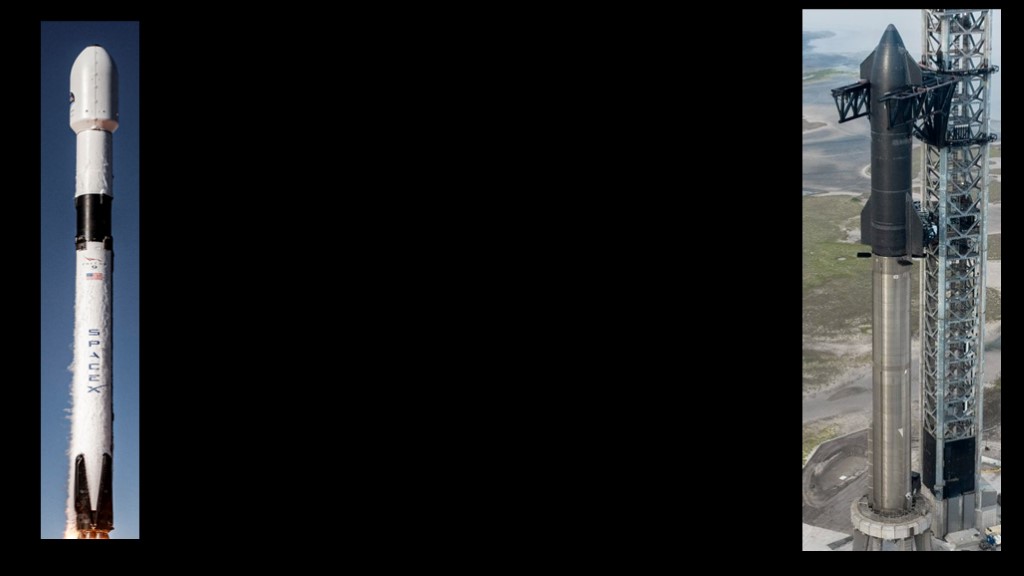
It's very tempting to think of the Starship architecture as just the bigger brother of Falcon 9, with a fancy new reusable second stage. Most of the discussion has focused on that second stage, but it turns out that there are some very interesting things going on with the whole package, things that make it a very different rocket than Falcon 9.
The key difference is that Falcon 9 is a mostly normal rocket that can operate in a reusable mode, while Starship is designed and optimized to be highly reusable. This video will look at one of the ignored parts of rocketry, staging.
(show video)
This is eager space.
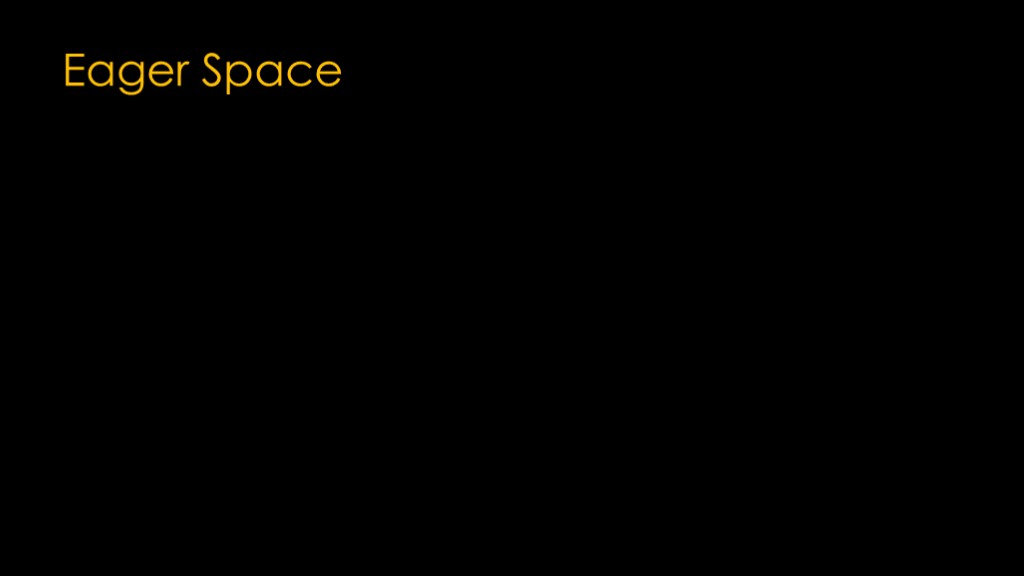

To understand how starship staging is different, we'll need to look at how a typical rocket approaches stage design
On the Atlas V 501 rocket - which uses no solid rocket boosters - the booster does 55% of the work to get the payload to orbit, and the upper stage does 45%.
The beefiest Atlas V - the 551 version with 5 solid rocket boosters - sees the booster doing 69% of the work and the upper stage only doing 31%.
That's a pretty typical ratio. The Atlas V stages at around 276 seconds into the flight, or roughly halfway to orbit.
The Falcon 9 is very different. It puts the beefiness into the upper stage, with that stage doing 61% of the work. It stages at around 150 seconds in expendable mode and earlier in reusable mode.
Atlas V uses a Centaur upper stage which is very efficient but low on thrust, so that required a beefier booster stage.
Falcon 9 needed a vacuum engine for the upper stage and SpaceX chose to adapt a first stage engine for the task, resulting in a high thrust upper stage engine. That worked well as they wanted to stage early to enable reuse.
Falcon 9 is the closest sibling of Starship and we'll therefore look at what happens during Falcon 9 staging next...

The first stage is thrusting along, we hit main engine cutoff (or MECO), there's a pause, the stages separate, the first stage starts to turn around, and then the second stage ignites.
Watching a few launch videos, I recorded the following times.
If we starting measuring from when the engines shut off, it's 3-4 seconds before the stages separate, and then 7-10 seconds after that before the second stage ignites, so that's 10-14 seconds without thrust.
For the first stage, it takes approximately 20 seconds after MECO for the stage to turn around and relight its engines to boost back to the launch site. That's assuming the booster is returning to the launch site - most Falcon 9 launches land on a drone ship.
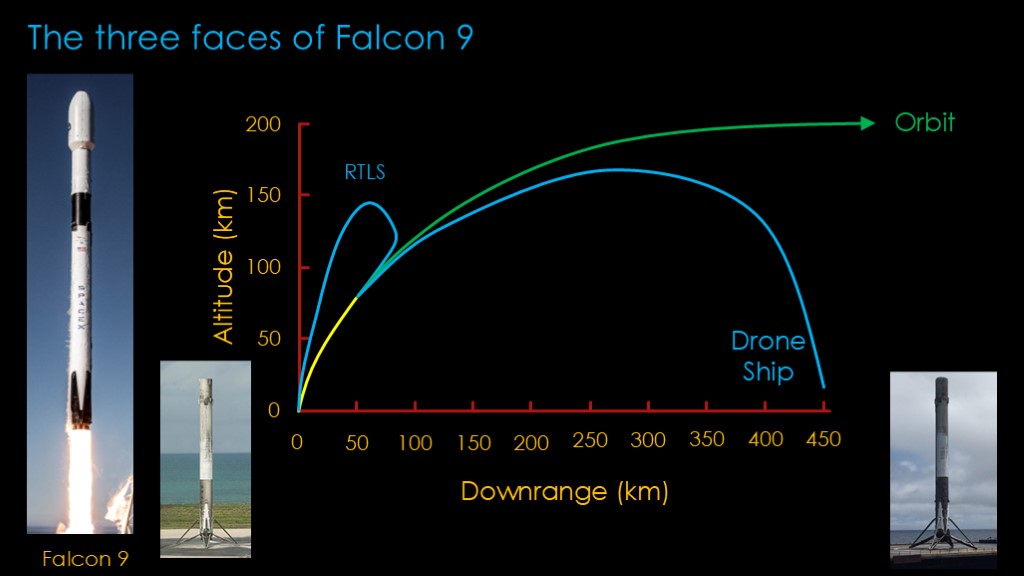
Falcon 9 operates in three modes...
The first one is expendable mode - the booster fires until it runs out of fuel, the second stage takes over, and the spent booster either breaks up on reentry and/or crashes into the sea. That's traditional rocket mode, and it's used when the payload needs all the performance that Falcon 9 can provide.
The second mode is drone ship recovery. It's used when Falcon 9 has enough performance to put the payload in the desired orbit while reserving enough propellant in the booster to coast over the water, reenter, and ultimately land on the drone ship. All starlink flights are designed to use this mode as it's the cheapest one per kilogram of payload, and many commercial flights also use this mode.
The third mode is return to launch site. It's used when Falcon 9 can save enough booster propellant to be able to get back to the launch site and still put the payload in the desired orbit.
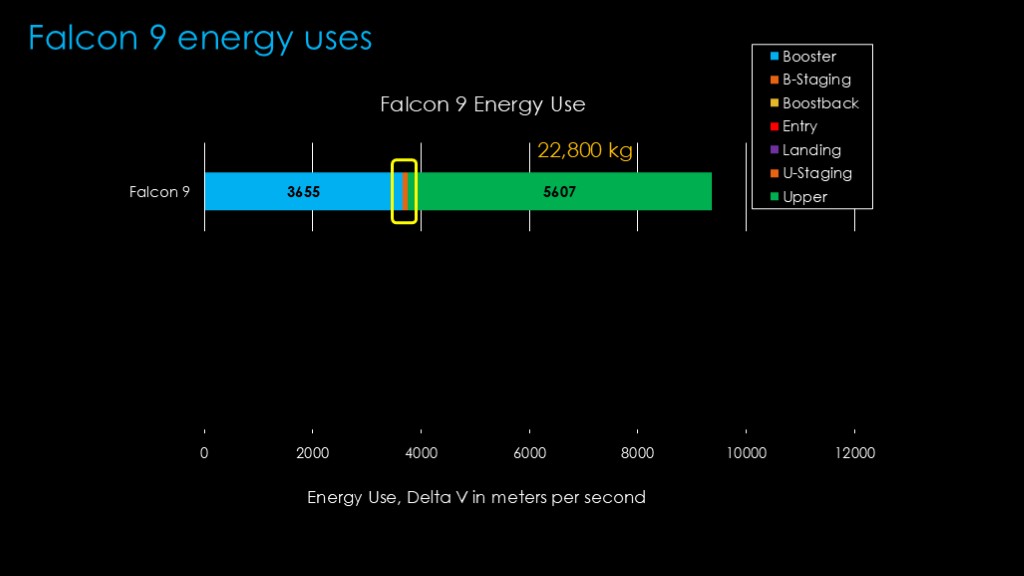
With that in mind, we can look at where Falcon 9 spends energy.
In expendable mode, the booster puts all of its energy into the second stage. In the coast phase between main engine cutoff and the start of the second stage engine there is a little bit of energy loss because gravity is slowing the rocket down during that time period. It's not particularly significant - perhaps 1% of the total energy. Falcon 9 can put 22,800 kilograms into low earth orbit in this mode.
If we look at Falcon 9 landing on a drone ship, there are two new usages of energy.
At the time of staging, the booster is travelling very fast and it will accelerate as it heads back towards the earth. A significant entry burn is required to slow the rocket down so that it will survive reentry into the atmosphere, and that takes quite a bit of energy. We also need to slow the rocket down to land, which requires some energy as well.
Looking at the numbers, we see that that energy the booster can give to the second stage is reduced because it needs to reserve energy for the entry and landing burns. That means the second stage needs to be able to give the payload more energy, and that is only possible with a smaller payload mass - around 16,500 kilograms.
Looking at the return to launch site scenario, things get more complex. We are now losing energy on staging on both the booster and the second stage. There is a large boostback burn to get us headed back to the landing site. There is a tiny entry burn because the boostback burn slows the booster down so much, and of course there is a landing burn as well. Once again, the second stage has to do more work, and the payload for this option is around 12,500 kilograms
This last scenario is the only one for Starship, and optimizing Starship will try to reduce these losses.
The entry burn doesn't do much in this scenario, so Starship will just eliminate it. We are stuck doing the landing burn, which leaves the very large boostback and the moderate staging burns as places we can optimize.
We'll start by looking at the energy going to staging.
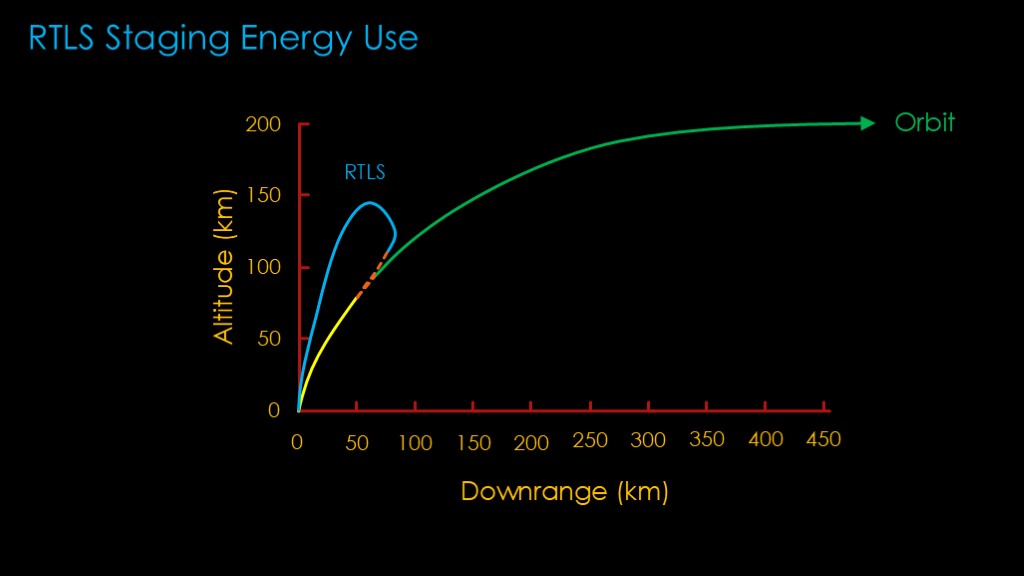
Here's a version of our previous graph showing the portions of the trajectory with staging losses. The booster energy loss is higher because it takes a long time for the cold gas thrusters on Falcon 9 to get the stage turned around.
There is luckily an established way to reduce these losses.
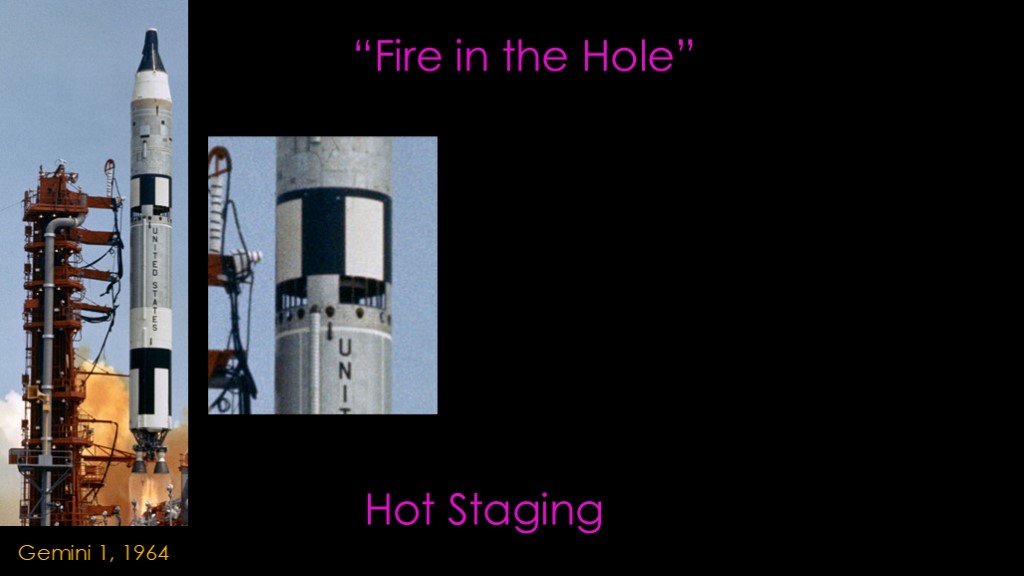
This is the first launch of the Gemini program in 1964, with the Gemini capsule being carried by a Titan II missile.
If we zoom in on the rocket we can see that there are holes in the rocket between the first and second stages. The allows us to start the second stage engines before the staging has taken place. Here's a view of staging from the Titan II second stage...
This technique used to be called "fire in the hole", but is now typically known as hot staging
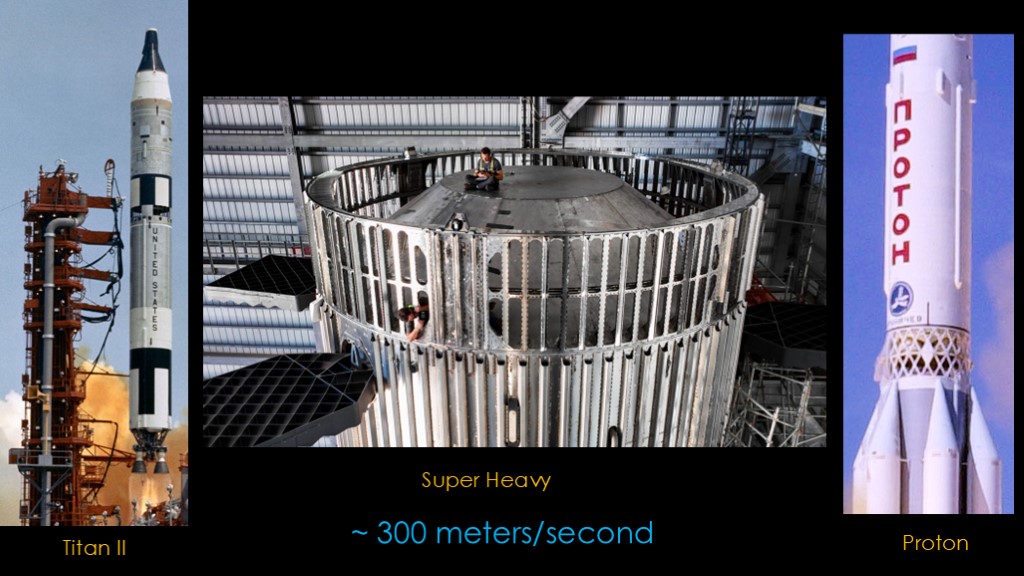
This technique was used on the Titan II and was also used by the Russian Proton rocket, which has a very distinctive latticework section between the two stages.
SpaceX has made this change on booster 9, with a ventilated section at the top of the Super Heavy Booster.
Hot staging allows us to mostly eliminate the coasting section the staging process, saving energy that can go to payload. It's not a lot - perhaps 300 meters/second or less of delta v.

We can now work on reducing the boostback losses.
Hot staging helps a little - we get rid of the long coast to get turned around and that means we are closer the launch site. But that's a small improvement.
The problem we have is simple - at the staging point, the Falcon 9 booster is travelling away from the launch site at perhaps 1250 meters per second, and the boostback burn needs to kill all that velocity before it can generate the velocity it needs to head back to the launch site.
That is why boostback is so expensive. What we really need is a way to reduce that velocity.
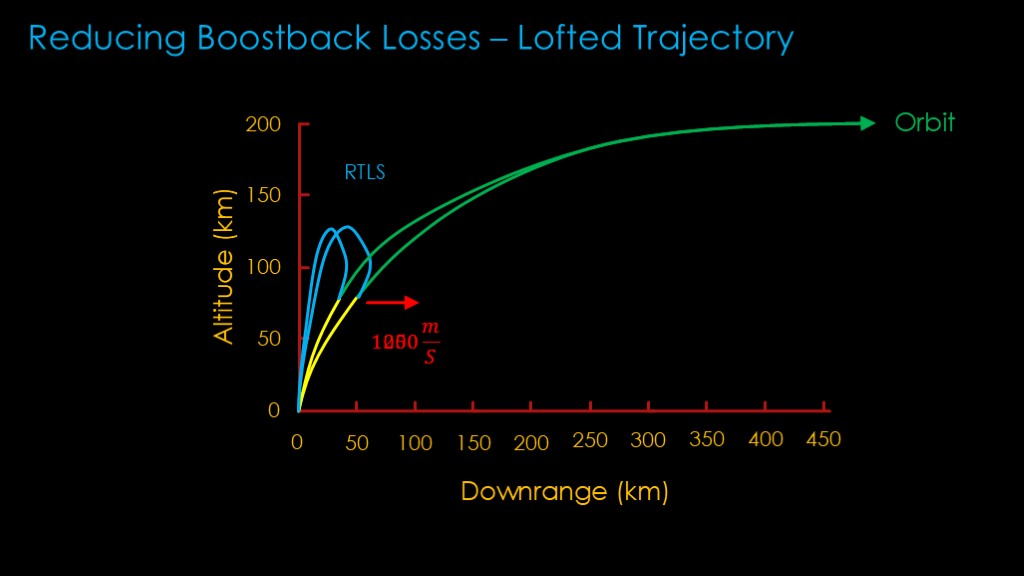
The trajectory to orbit here is a classical one - one that produces the highest payload. But it also produces high boostback energy requirements.
We can choose, however, to fly a trajectory where the booster spends more energy going up and less energy heading downrange - generally known as a "lofted" trajectory.
A lofted trajectory could reduce the horizontal velocity from 1250 meters per second down to 1000 meters per second. It is a less efficient trajectory overall but reducing the boostback cost could make it worthwhile.
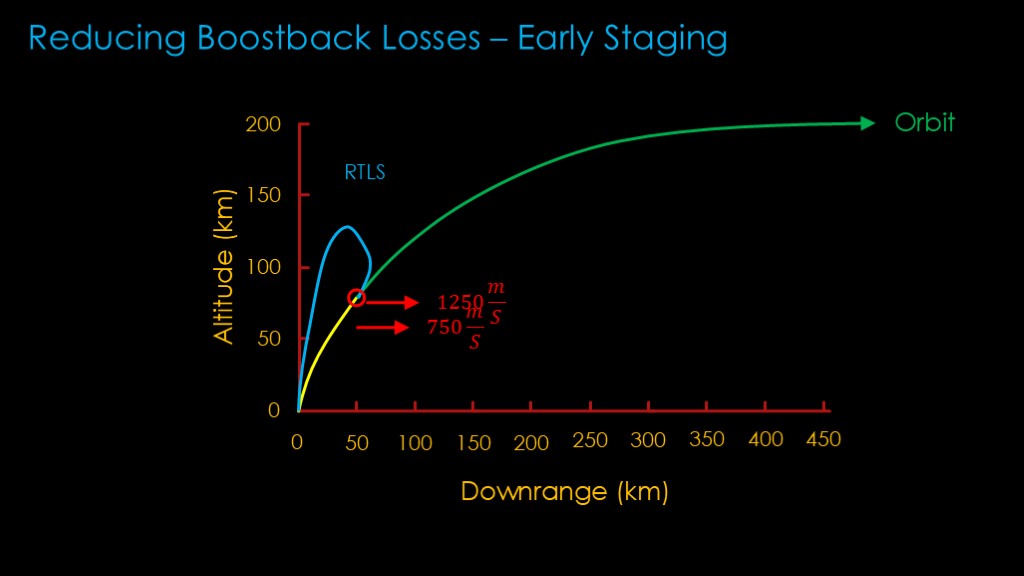
Another way to reduce the horizontal velocity is simply to stage earlier in the flight.
If we can move the staging even 10 seconds earlier in the flight, the horizontal velocity could be much less, and would significantly reduce the cost of the boostback burn.
To get this to work requires a number of changes. They don't make sense for Falcon 9 because they would reduce the payload for the drone ship missions, and that would not be good.
But Starship never does droneship landings, so optimizing for return to launch site makes sense.
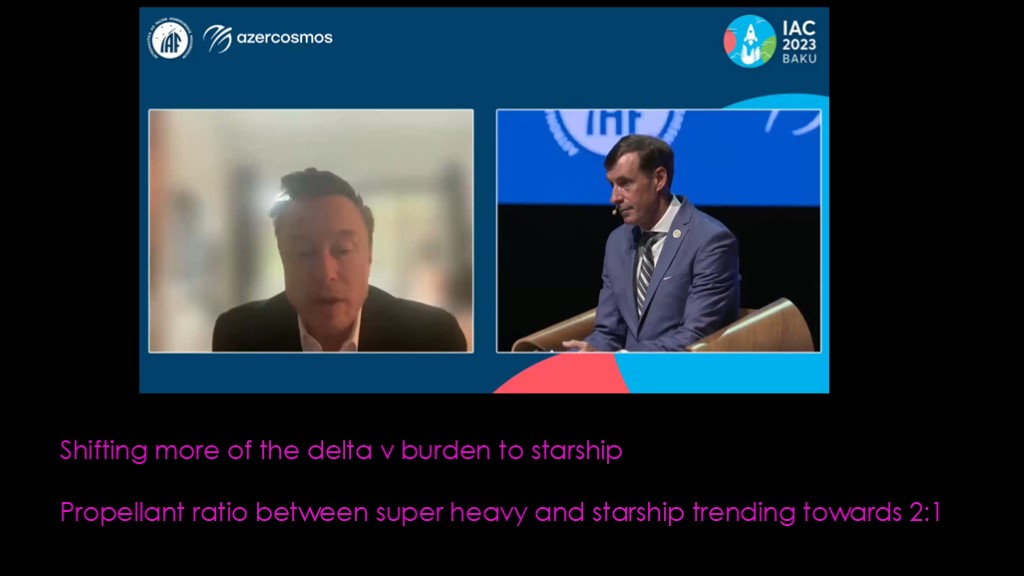
Elon Musk talked about this recently during an IAC 2023 session.
He mentioned shifting more of the delta v burden to starship which is exactly what happens with early staging - the booster does less of the work of getting into orbit and the second stage does more of the work.
He also mentioned that the propellant ratio between super heavy and starship was trending towards 2 to 1, which is the sort of detailed technical information that is great to get.
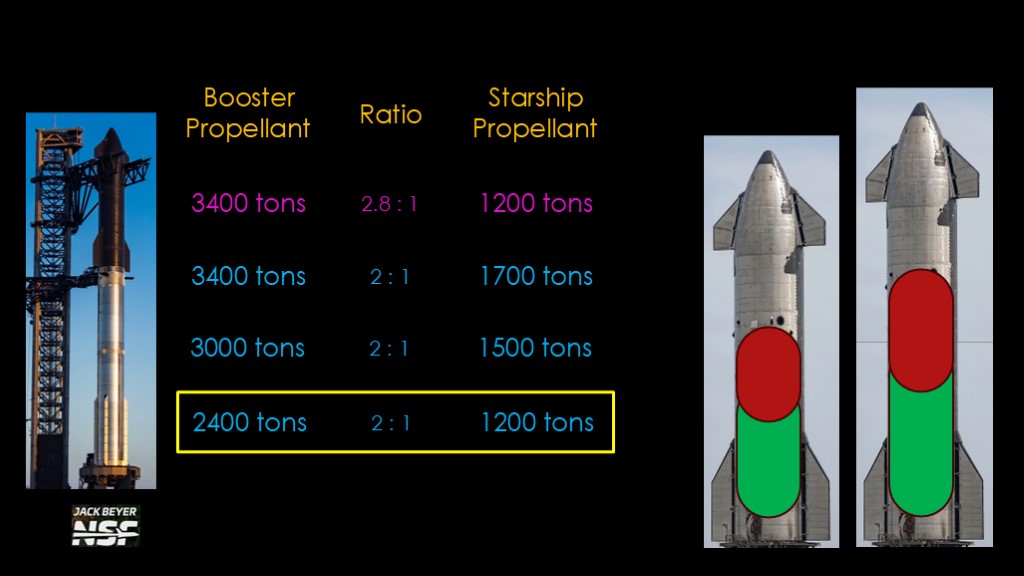
The current propellant ratio between super heavy and Starship is 2.8 to 1. This is already very low - Falcon 9 is 3.75 to 1, and commercial launchers like Atlas V starts at about 12 to 1 and goes up from there.
To get to a ratio of 2 to 1, there are three things we could do.
The first is a stretch to add 500 tons of propellant to starship.
The second is to reduce the booster propellant to 2400 tons.
The third is a middle ground, stretching starship to increase propellant and shrinking super heavy to reduce propellant. I chose these numbers to demonstrate, but others are possible.
All three hit the 2 to 1 ratio, and all three put more of the work of getting to orbit on starship.
Which one will they choose?
The one where they reduce the booster propellant is probably a non-starter, as it reduces the overall performance of the system *and* Musk has mentioned stretching starship to be longer in the past.
That leaves us two viable options. Just stretching Starship and leaving Super Heavy alone is the simplest change to make. It would add 9 meters to starship, and the change would look roughly like this.
The second is more complicated as it requires work on two vehicles.
Note that Musk said "trending towards 2 to 1, not at 2 to 1", so the ratio could easily be something like 2.2 to 1.
Can we figure out which one is more likely?
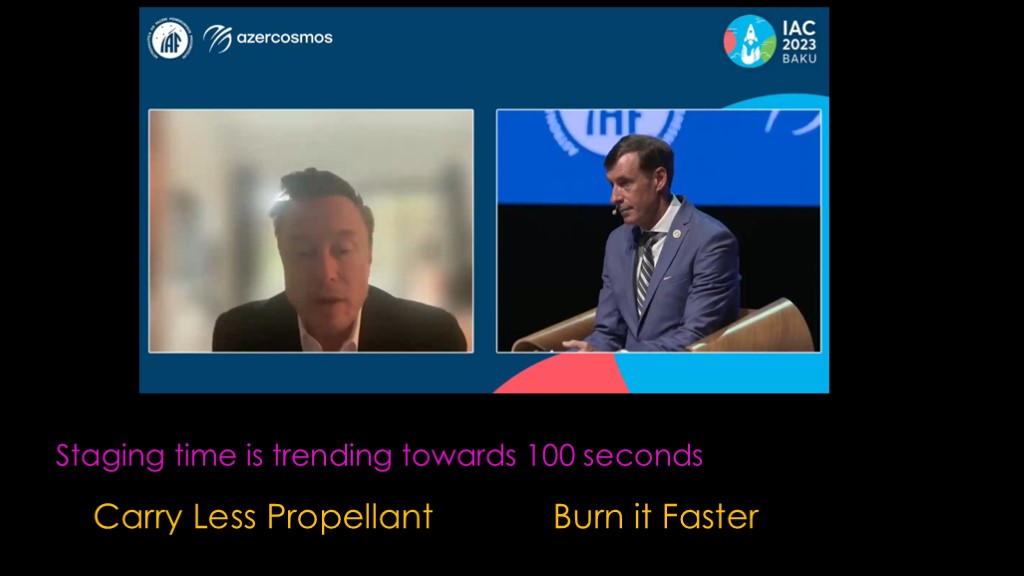
Musk mentioned one more thing at the IAC session, and that was that staging time is trending towards 100 seconds. That's another bit of useful technical data.
To accomplish early staging, there are only two options. You can carry less propellant, or you can burn it faster.
We have an option that carries less propellant. Let's explore faster propellant burning.
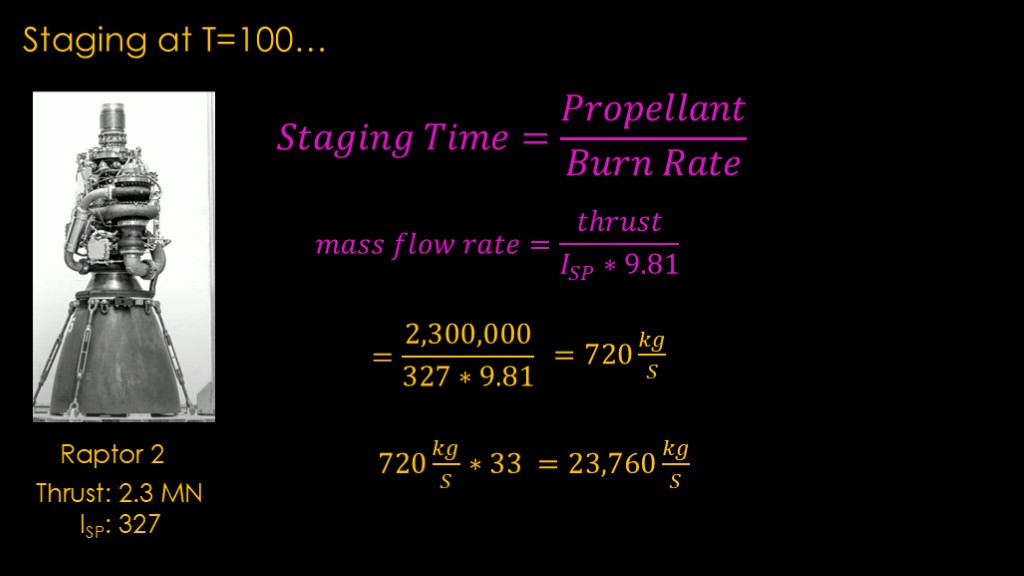
We can surprisingly figure this out fairly easy.
The staging time in seconds is equal to the propellant burned in kilograms divided by the propellant burn rate in kilograms per second. This is some wasted propellant - startup consumes some before liftoff and there is some left in the tanks at the end because running engines to empty is very bad, but this will get us pretty close.
It turns out the burn rate is also quite easy to measure. It's known as mass flow rate, and it is equal to the thrust of the engine in newtons divided by the specific impulse times 9.81. The numbers for the Raptor 2 say that it has a thrust of 2.3 million newtons and a specific impulse of 327, both at sea level.
Plug those numbers in, and we get a mass flow rate of 720 kilograms per second. There are 33 engines, so the total is 23,760 kilograms per second.
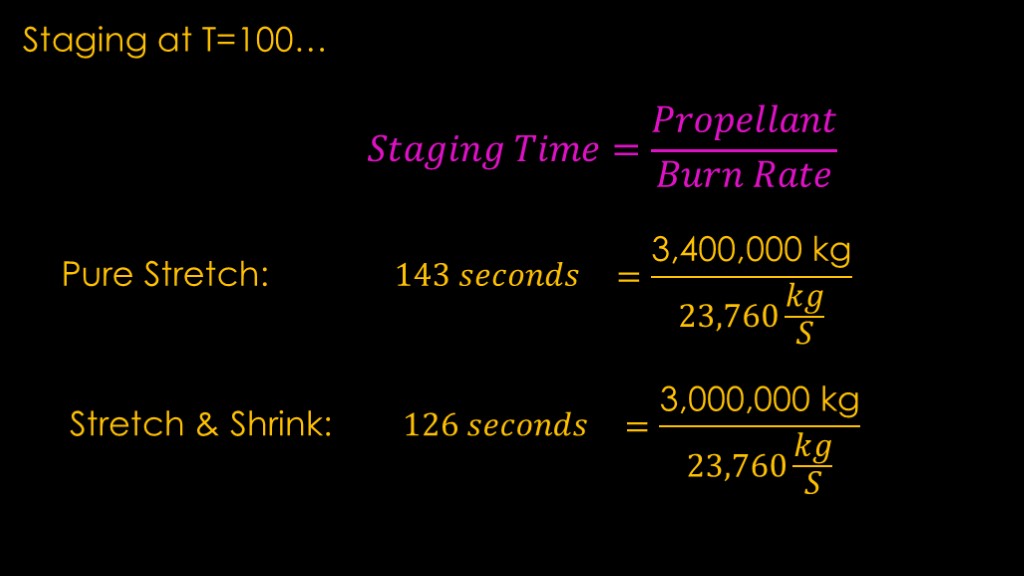
We can now plug the mass flow into our equation, and when we do that we get 143 seconds for the pure stretch option and 126 seconds for the stretch and shrink option.
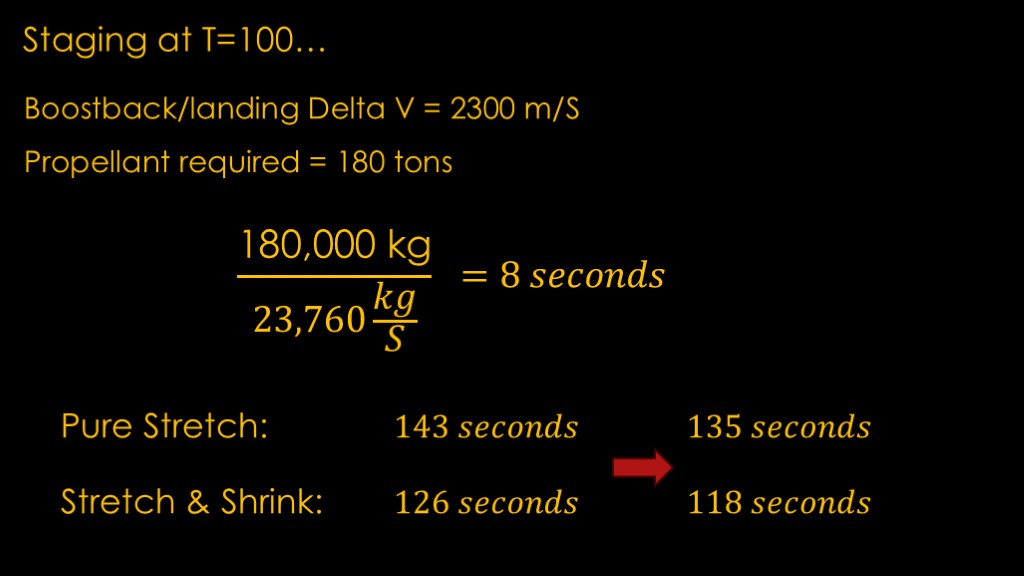
That's for burning all the fuel, but of course we need to leave fuel for the boostback burn and the landing.
I'm going to allocate 2300 meters/second of delta V to that, which is probably double what it will actually be. Doing some math tells me that it will take 180 tons propellant to do that. Based on our mass flow rate, that's 8 seconds worth of fuel for the booster.
That pushes our staging times down to 135 and 118 seconds, which is looking more reasonable.
To get it lower, we need engines with a higher mass flow rate.
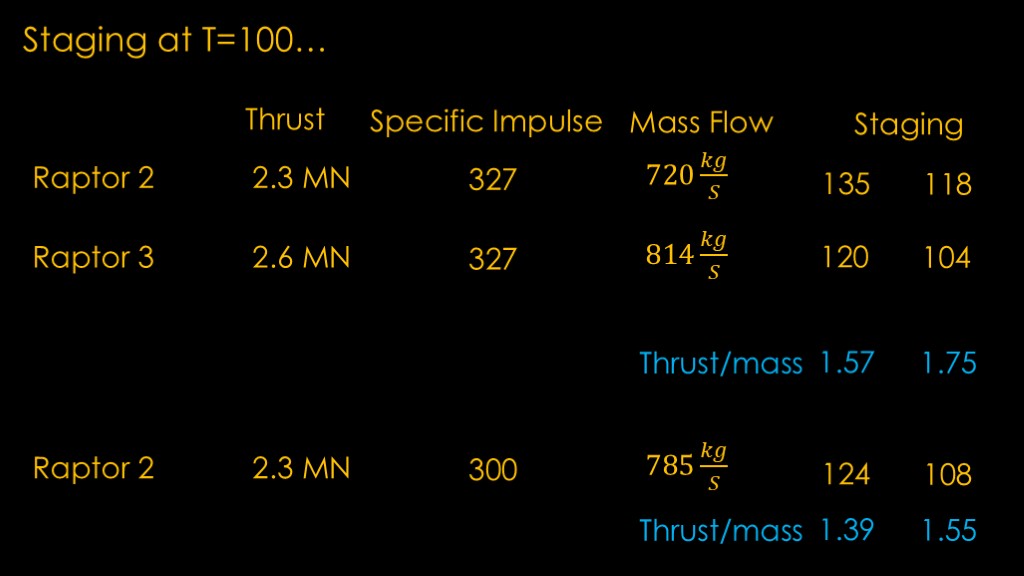
Our current numbers are based on the Raptor 2.
There is *supposedly* a Raptor 3 engine in the works, with a thrust of 2.6 meganewtons and a mass flow rate of 814 kilograms per second. That gets us to 120 seconds for the stretch version, 104 seconds for the stretch & shrink version.
That looks pretty good, but there's *another* problem. Musk stated that the thrust/mass ratio would be 1.3 to 1.4, and our first version is close to 1.6 and our second version is 1.75.
We can make the numbers align better if the Raptor 2 has a lower specific impulse. If the impulse is only 300, the mass flow rate goes up and therefore the staging happens faster. That gives slightly more reasonable thrust/mass numbers but still not what we are expecting.
So this is all quite confusing, and we'll need to wait to see what SpaceX actually does for the staging time of Starship.
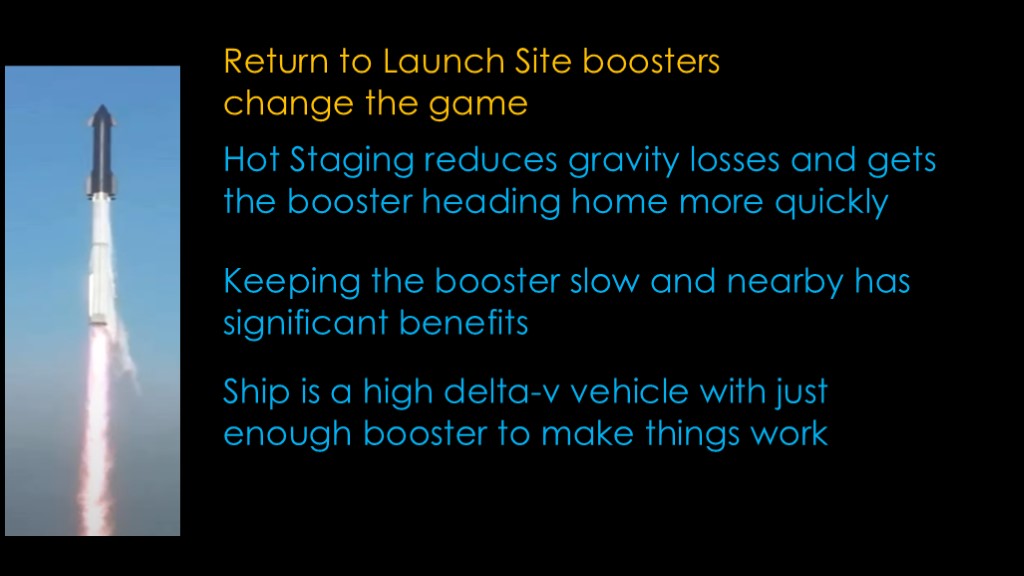
Starship is a rocket like no other because it only does return to launch site, and that changes the rules of the game.

If you enjoyed this video, please send a card to super heavy to let it know that it's exactly the right amount of heavy.